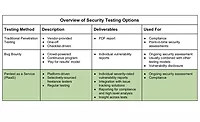The 5 most important aspects of a comprehensive cloud security program

Image via Pixabay
There are many benefits to utilizing the cloud for data storage and IT infrastructure, including reduced costs, faster deployment, ability to scale and continuous protection. However, there are also complexities and challenges that enterprises face when securing their cloud environments.
Enterprise cloud security is a broad term that can include security policies, technologies, applications and controls that are used to protect sensitive enterprise and user data wherever it is exposed in public, private or hybrid cloud environments. These are all important factors because they enable organizations to balance productivity and security as they embrace digital transformation and cloud-based tools and services.
The growing reliance on the cloud
With inherent benefits that on-prem doesn’t offer, including flexibility, ability to scale and 24/7/365 support, and more importantly, a usage-based pricing model, the cloud has emerged as the backbone of many companies’ IT infrastructure. Cloud platforms also tend to be more secure, with the “Big 3” platforms employing high-quality IT and security talent.
However, with the increasing reliance on the cloud, it has also become a prime target for bad actors with nefarious motives. In fact, a 2023 global cloud security study found that 39% of businesses experienced a cloud-based breach in 2022, rising 4% from 2021. The study also revealed there has been a large increase in sensitive data stored in the cloud. Of the nearly 3,000 IT professionals surveyed, 89% of respondents said that 40% of the data that their companies store is considered sensitive.
Overcoming cloud security challenges
IT leaders must contend with a growing list of cloud security challenges with protecting data from authorized access, leakage and loss across different cloud platforms and devices as their top priorities. For companies relying on private clouds, detecting and responding to advanced threats and attacks that target their cloud infrastructure in applications in real-time is a 24/7/365 job which is why many businesses opt to outsource this function to service providers that use advanced technologies, including AI, to detect and thwart threats.
Whether companies outsource their cloud security or manage it in-house, one of the more complex challenges facing organizations is, believe it or not, people. According to 55% of study respondents, the leading cause of cloud breaches is human error. Education and training is the best way to mitigate the potential for mistakes made by employees,
A hybrid cloud approach can offer many benefits, but it also poses a challenge for organizations: how to comply with the diverse security standards and settings of different cloud providers. To overcome this challenge, organizations need to keep track of and manage their cloud usage and activity across users and applications.
In addition to addressing various standards and configurations, complying with regulatory and industry requirements for data privacy and security is of the utmost importance for a couple of reasons. First, because a lack of compliance can lead to legal action and steep fines should a breach occur, and second, a breach is bad for business and can tarnish a company’s brand.
While the U.S. doesn’t have a GDPR-like regulation (yet) the California Consumer Privacy Act (CCPA) comes close. The CCPA gives consumers more control over the personal information that businesses collect on them. It gives them a series of rights, such as knowing how this information is used and shared, and the right to delete their information once asked, among others.
The CCPA has “teeth” too. In August 2022, California Attorney General Rob Bonta announced the state had penalized Sephora $1.2 million and required them to comply with injunctive terms for tracking consumers through third parties — Sephora had failed to comply with the “right to know” and “right to opt-out” stipulations of the CCPA.
To address these challenges among others, enterprises need to adopt a comprehensive and integrated approach to cloud security that covers all aspects of their cloud environment, including:
- Identity and access management: ensuring that only authorized users and devices can access cloud resources and data
- Data protection: encrypting, backing up, and restoring data in transit and at rest in the cloud
- Threat prevention: blocking malicious traffic, malware, and ransomware from reaching or compromising cloud resources and data
- Security monitoring: collecting and analyzing logs, events, and alerts from cloud resources and applications to detect and respond to anomalies and incidents
- Compliance management: auditing and reporting on cloud security posture and compliance status against relevant standards and regulations
The cloud has nearly become ubiquitous in the 2023 business landscape and for good reason. With new advances in AI, it will become even more of a requirement for companies competing in the “AI economy.” The enormous amount of personal, financial and corporate data stored in the cloud should put IT leaders on high alert. Executing a comprehensive cloud security plan will help companies not only avoid fines and penalties but will help to mitigate the risk of a catastrophic data breach.
Looking for a reprint of this article?
From high-res PDFs to custom plaques, order your copy today!







